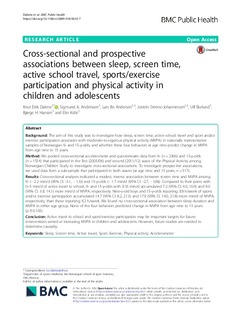Cross-sectional and prospective associations between sleep, screen time, active school travel, sports/exercise participation and physical activity in children and adolescents
Dalene, Knut Eirik; Anderssen, Sigmund Alfred; Andersen, Lars Bo; Steene-Johannessen, Jostein; Ekelund, Ulf; Hansen, Bjørge Hermann; Kolle, Elin
Journal article, Peer reviewed
Published version

View/
Date
2018Metadata
Show full item recordCollections
Original version
Dalene, K. E., Anderssen, S. A., Andersen, L. B., Steene-Johannessen, J., Ekelund, U., Hansen, B. H., & Kolle, E. (2018). Cross-sectional and prospective associations between sleep, screen time, active school travel, sports/exercise participation and physical activity in children and adolescents. BMC Public Health, 18(1), 1-10. 10.1186/s12889-018-5610-7Abstract
Background
The aim of this study was to investigate how sleep, screen time, active school travel and sport and/or exercise participation associates with moderate-to-vigorous physical activity (MVPA) in nationally representative samples of Norwegian 9- and 15-y-olds, and whether these four behaviors at age nine predict change in MVPA from age nine to 15 years.
Method
We pooled cross-sectional accelerometer and questionnaire data from 9- (n = 2366) and 15-y-olds (n = 1554) that participated in the first (2005/06) and second (2011/12) wave of the Physical Activity among Norwegian Children Study to investigate cross-sectional associations. To investigate prospective associations, we used data from a sub-sample that participated in both waves (at age nine and 15 years, n = 517).
Results
Cross-sectional analyses indicated a modest, inverse association between screen time and MVPA among 9- (− 2.2 min/d (95% CI: -3.1, − 1.3)) and 15-y-olds (− 1.7 min/d (95% CI: -2.7, − 0.8)). Compared to their peers with 0–5 min/d of active travel to school, 9- and 15-y-olds with ≥16 min/d accumulated 7.2 (95% CI: 4.0, 10.4) and 9.0 (95% CI: 3.8, 14.1) more min/d of MVPA, respectively. Nine-y-old boys and 15-y-olds reporting ≥8 h/week of sports and/or exercise participation accumulated 14.7 (95% CI: 8.2, 21.3) and 17.9 (95% CI: 14.0, 21.8) more min/d of MVPA, respectively, than those reporting ≤2 h/week. We found no cross-sectional association between sleep duration and MVPA in either age group. None of the four behaviors predicted change in MVPA from age nine to 15 years (p ≥ 0.102).
Conclusion
Active travel to school and sport/exercise participation may be important targets for future interventions aimed at increasing MVPA in children and adolescents. However, future studies are needed to determine causality.
